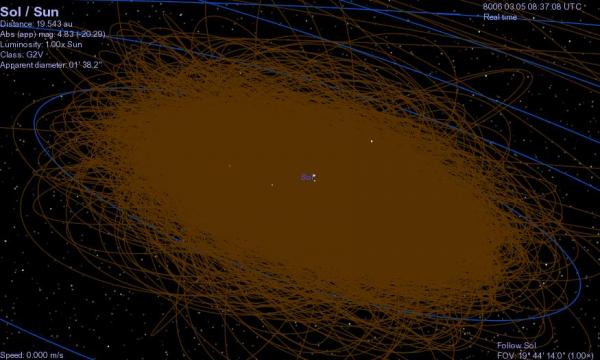BY LETTER
Sol Asteroid Belt
Galactography > Regions of Space > Inner Sphere
Galactography > Places and Locales
Galactography > Other Major Polities, Empires, and Meta-Empires > Solar Organisation
Galactography > Places and Locales
Galactography > Other Major Polities, Empires, and Meta-Empires > Solar Organisation
 Image from Steve Bowers | |
| The orbits of several hundred larger Solsys asteroids and their associated colonies are shown in this image | |
Sophonts: about 160 billion, mostly a diverse range of nearbaseline tweaks (75 billion, chiefly Homo sapiens cosmoi, Homo sapiens neocosmoi, Homo sapiens spatialis, Homo spatialis spatialis, Homo spatialis asteroidensis, Homo sapiens asteroidensis, Homo sapiens ceresensis, Homo sapiens vestensis, Homo sapiens federatensis, and Homo sapiens superior), dormbots (24 billion), and copies (20 billion), with a smaller number of true baselines (9 billion Homo sapiens sapiens, the largest known population of baselines in the Inner Sphere), cyborgs (8 billion), vecs (5 billion), animants (5 billion), ais (2 billion), rianths (0.5 billion), bioborgs (0.1 billion), and provolves and meta-provolves (134 species and an estimated 20 million individuals, chiefly mammals (Pan sapiens, Pan superior, Pan amicus, Canis neofamiliaris, Felis sapieospatialis, Elephas sapiens spatialis, Rattus sapiens anthropoidus), although Nova Apama supports a colony of derived neo-cuttlefish (Sepia sapiens),
Planetology: The asteroid belt is a swarm of masses of rock mountains, sometimes whole but more often fragmented (through millions of years of collision), tumbling through the space in the region between Mars and Jupiter. It is fairly typical of asteroid belts throughout the known universe.
Comments: Densely populated with a myriad of habitats, singleships and drones, the asteroid belt has the largest population of any region in the Sol System. Over the centuries it has absorbed many waves of immigrants (beginning with the Interplanetary age colonists, then the survivors of the Technocalypse returning from outsystem, the billions expelled from Earth by GAIA, and refugees from the Empires Wars and the Version War. In the process almost every cubic meter of real estate has been claimed by private individuals, prospectors, startups, franchises, and claimjumpers. The increasing population means that mining has not been possible since the late Federation era, but by that time the megacorps were all exploring outsystem anyway. Although the population is divided among thousands of inhabited rocks of various sizes, the largest asteroids, such as Ceres and Vesta, which were among the first settled, have the largest populations, in vast underground habitats featuring both claustrophobic tunnels and great open-space biospheres many kilometers in diameter. The Belt is still the Sol System's major manufacturing and industrial centre, but all manufacturing nowadays is done through nanorecyling of waste materials, raw resources being in short supply. Ceres, the largest asteroid, is home to the headquarters of the old Belt Alliance. Ceres's main city is Freeport, located directly adjacent to Hamada Landing. Freeport is still one of the largest spaceports in the Solar System, and extends for tens of kilometres over and under the surface of Ceres.
For all the many tourist attractions, the Belt is still the least visited area outside tourist traps like Vesta, New Mondo and Hygiea. Most belters look down on tourists and prefer to "live their lives as real solar system inhabitants rather than museum exhibits".
Related Articles
- 216 Kleopatra
- Asteroid
- Asteroid Mining, Belt Mining
- Belt, Asteroid
- Belter - Text by M. Alan Kazlev
[1] Any resident of an asteroid belt, including citizens of civilised belts such as the Barnard Belt, Sol Main Belt, the Mirthsen-Simoris Spinward Marches, or any of the other innumerable belts in known space. Many belters have never been in a spaceship, let alone set foot on a planet or large orbital.
[2] Historical/Obsolete - A person who practiced the profession of asteroid prospector and miner (belt mining), usually working alone or with a small number of partners. - Ceres
- Ceres - The Early Years
- Ceres Astrospace
- Ceres Astrospace Delta
- Ceres Mater
- Solsys
- Vesta
Appears in Topics
Development Notes
Text by M. Alan Kazlev
Initially published on 02 August 2002.
Initially published on 02 August 2002.






